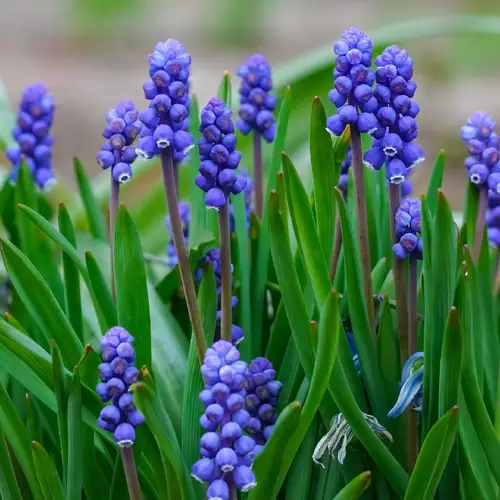How can I prune my Blue grape hyacinth?
Pruning your Blue grape hyacinth is a fairly simple process. First, you will need a reliable set of hand pruners or hedge trimmers. You may use a clean pair of sharp scissors if you don’t have pruners or garden shears on hand. It’s important to always clean your gardening tools before and after using them to prevent the possibility of spreading disease or infection to other plants. To prune your Blue grape hyacinth simply allow your plant to go dormant over the Winter. Some time between late winter and early spring – or when new growth starts to appear – take your clean pruners or trimmers and cut away any dying, damaged, yellow or declining foliage. Repeat this process until you reach the base of the plant or until there are no dead pieces left to cut. When pruning, be careful not to damage the new growth that may be emerging near the base of your plant. These parts cannot be restored and pruning can increase the ventilation of the plants and facilitate their growth. Any pruning that is done to this plant should be cut straight across the blades or stems. No angled cuts are required. Diseased leaf blade foliage can be removed as it appears. This could be done anytime when your Blue grape hyacinth is growing.
![more]()
What should I do after pruning my Blue grape hyacinth?
Once you’ve pruned your plant, you should dispose of the stems and leaves either by composting the healthy ones or throwing out the diseased parts. You can also fertilize just before or after pruning, which gives Blue grape hyacinth a little vitamin boost that can provide it the nutrients needed to better protect itself from any nearby pathogens or diseases. Do not water the Blue grape hyacinth immediately after pruning as this can lead to fungal infestation of the plants through the wounds. You don’t need much after care when you’re done pruning. It might benefit from light watering and some liquid plant food to encourage new growth.
![more]()
How can I prune my Blue grape hyacinth during different seasons?
Early spring and late winter are the best times to prune your Blue grape hyacinth on a large scale. If you want to control the size of your Blue grape hyacinth, you can prune them as you wish, but be careful not to prune more than a third of the size of the plant. Yellow and diseased leaves may appear during the summer months when the Blue grape hyacinth is growing vigorously and these types of leaves need to be pruned back immediately. These parts of the Blue grape hyacinth cannot be restored and pruning increases the ventilation of the plant and facilitates its growth.
![more]()
When should I prune my Blue grape hyacinth through different stages of growth?
Strategic pruning is usually done at different times of the year or during certain stages of growth depending on the plant. However, knowing when to prune your Blue grape hyacinth depends on where you live and how established your plant is. For example, if your Blue grape hyacinth is a new resident, it’s a good idea to wait until the plant starts to grow back before you start pruning. On the other hand, if your plant is already established, you will want to prune the dry or dead parts in plant before new leafy growth appears in early spring or late winter. This is the time of year when plants are dormant and pruning causes the least damage to them. This is also the best time of year to do more extensive pruning. It’s important to note that if Blue grape hyacinth is pruned too late in the season, it can leave new growth at risk for damage or disease. However, if your Blue grape hyacinth is indoors this is not a problem and you can prune at any time. Since this can affect the long-term health and appearance of your plant, it’s important to keep this in mind when deciding when and how to prune. As your Blue grape hyacinth grows larger over time, you can trim it as needed after annual pruning. Dead, damaged, or diseased leaf blade foliage can be removed as it appears. This could be done anytime when your Blue grape hyacinth is growing.
![more]()
![icon]()
Get tips and tricks for your plants.
Keep your plants happy and healthy with our guide to watering, lighting, feeding and more.
Download the App for Free






















